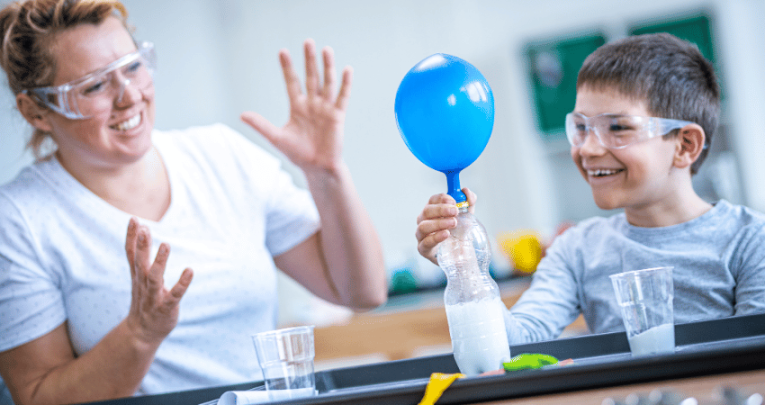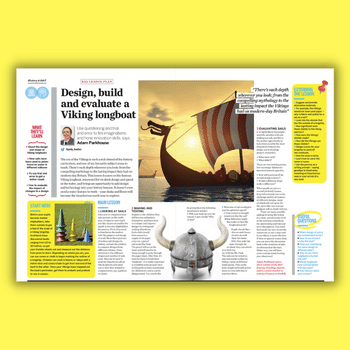Experiential learning – Boost learning with active participation

What is experiential learning, how might you use it in your classroom and does it lead to meaningful learning? Read on to find out…

- by Teachwire
- Classroom expertise and free resources for teachers

You can’t learn to ride a bike via a worksheet – sometimes you just need to get on and peddle. Here’s why experiential learning should be central to your offering in school, not just an optional add-on…
What is experiential learning?
Kolb’s Experiential Learning Theory
Kolb’s Experiential Learning Theory is the foundation of the experiential learning approach. David Kolb proposed that learning is a cyclical process involving four stages:
- Concrete experience: This is where students have a direct, hands-on experience, like conducting an experiment or participating in a group activity.
- Reflective observation: After the experience, students reflect on what happened, considering what worked, what didn’t, and why. This stage encourages deeper thinking about their experiences.
- Abstract conceptualization: Here, students develop theories or ideas based on their reflections. They start to make connections between the experience and broader concepts or lessons.
- Active experimentation: Finally, students apply what they’ve learned in new situations, testing their ideas or theories in different contexts.
Understanding Kolb’s cycle can help you design lessons that guide students through these stages, ensuring they not only engage in activities but also reflect, conceptualise and apply their learning in meaningful ways.
In essence, Experiential Learning Theory is based on the idea that students learn best by doing. Instead of just reading about a concept or listening to the teacher, students actively participate in hands-on activities that let them experience the material directly.
“In essence, Experiential Learning Theory is based on the idea that students learn best by doing”
This approach encourages them to reflect on their experiences, connect them to what they already know, and apply what they’ve learnt in real-world situations.
For teachers, this might mean designing lessons where students engage in projects, experiments or school trips that make learning more tangible and memorable.
Benefits of experiential learning
Some of the key benefits of experiential learning include:
- Enhanced engagement: Students are more engaged and motivated when actively participating in hands-on activities rather than passively receiving information.
- Deeper understanding: Experiential learning allows students to connect theory with practice, leading to a deeper understanding of concepts.
- Improved retention: Learning through experience often leads to better memory retention, as students are more likely to remember what they have actively done.
- Critical thinking development: By reflecting on their experiences, students develop critical thinking and problem-solving skills.
- Real-world application: Experiential learning helps students apply their knowledge in real-world contexts, making learning more relevant and practical.
- Collaboration and social skills: Many experiential learning activities involve group work, which fosters collaboration, communication and teamwork among students.
- Adaptability and resilience: Experiencing real-world challenges helps students become more adaptable and resilient, preparing them for future learning and life situations.
Increasing your experiential learning offering can feel overwhelming, but as teachers we have the amazing chance to give students real experiences that they will remember for years to come – something that even the snazziest of worksheets can’t ever hope to match.
Facilitating experiential learning
With practical subjects it’s easy to accept the need for practical learning, but why do we decide some subjects are more theory than hands-on?
Experiential learning offers us an opportunity to challenge this ‘one or other’ approach. If you teach a subject that is often labelled ‘academic’, consider how you could transform the concepts you teach into an activity or experience.
Experiential learning examples
Role play or improvisation
By getting students to act out scenarios they have to think in real-time, reacting to changing situations. This allows pupils to explore a range of outcomes in a safe place where mistakes don’t have real-life consequences.
Explore the same scenario in a number of different ways by giving each group a different set of information, tools or objectives. If you’re running a whole-class activity, substitute students from the benches as the task continues, so all students are involved.
Project-based learning
The aim here is to get students to ‘do’ rather than ‘learn’. Here’s some ideas to get you started:
- Design and build a Viking longship
- Let students be forensic scientists and investigate a crime scene
- Explore forces by making hovercrafts and speed boats
- Create a French pavement cafe and order snacks and beverages
- Play Consequences to learn the features of rivers
- Make pop-up books to explore mechanisms
- Learn about budgeting by creating your own picnic
- Discover the science behind popping candy
- Organise a vocabulary bartering activity in an imaginary marketplace
What, so what, now what
Use the phrase ‘what, so what, now what’ to evaluate almost any situation. It gives students a way to quickly reflect on what they have done.
- ‘What’ helps you recap the choices you made
- ‘So what’ refers to the impact they had
- ‘Now what’ is about choosing the next steps
This also links well with other areas of pedagogy such as adaptive teaching. Each ‘what’ allows students to achieve a higher level of reflection and understanding.
Offer various routes
Ask students to choose the method or approach they want from a range of options. For example, let them choose from different soil types when growing plants in science or choose from different scenarios when it comes to ending a story in English. Have fun comparing the outcomes.
Link up with parents and the community
What jobs or hobbies do students’ parents do? Can they be used to complement a subject? Or can you host a standalone session where you invite students to explore the job and some of its main tasks?
Put out requests on your newsletter or local Facebook page for homemade resources. Often community members are pleased to be able to contribute in a practical and direct way, such as making costumes for a medieval project or a mini model of a canal lock, for example.
School trips
Taking students on a school trip to a local museum, zoo or farm allows them to experience learning outside the classroom.
For example, visiting a farm can help children better understand agriculture, animal care and food production.
Outdoor learning
Take your class outside to observe nature, collect leaves or measure shadows. This can turn a simple lesson into an immersive learning experience.
Cooking and baking activities
When learning about measurements or fractions in maths, cooking in the classroom can give students a tangible way to apply these concepts.
Storytelling and puppetry
Encourage students to create and perform their own stories or puppet shows to help them develop language skills, creativity and confidence.
Downsides of experiential learning (and solutions)
Funding and resources
It can be expensive, particularly if you work with outside partners, to deliver experiential learning sessions. This is why using supportive partners from parents and the community can be an effective way to build a programme without cost.
Training and planning time
You know your subject the best and will be able to identify where to start or increase your experiential learning in a way that avoids costly training.
Encourage collaboration among your colleagues by asking them to suggest experiential learning ideas for their area of expertise.
If you have several groups in each year, swap and share sessions. Set aside a training day if possible so teachers can prepare, or offer CPD opportunities focused on experiential learning strategies.
Adding to your workload
If you have no time for practical planning or little support from colleagues, trying to organise experiential learning can feel like a burden.
If this is your scenario but you’re still keen to try, it’s best to start small. Add a few sessions in each term and build up from there. If you start too ambitiously you may feel overwhelmed or run out of steam.
You may want to experiment with using a blended learning approach, where some content is delivered outside of class time, allowing in-class time to focus on experiential activities.
Classroom control
Remember that activities don’t always have to mean noise and chaos. After all, a focused child is often a quiet one.
Set out your expectations clearly before any experiential learning lesson to ensure it’s enjoyable for both you and your students.
Assessment
Traditional assessment methods like tests and quizzes may not adequately measure the learning outcomes of experiential activities.
Assessing experiential learning can be subjective and difficult to standardise. Make sure to develop rubrics that clearly define the criteria for evaluating experiential learning outcomes.
Use a combination of formative assessments, such as reflections, peer reviews, and project-based assessments, to capture a comprehensive picture of student learning.
Risk of superficial learning
Without proper reflection and integration, students may engage in activities without deeply processing the learning. This can result in superficial understanding rather than meaningful, long-term learning.
To avoid this, incorporate structured reflection activities before, during, and after the experiential learning. Encourage students to make connections between their experiences and the broader curriculum. Guide discussions to ensure that key concepts are understood and retained.
Hannah Day is head of art, media and film at Ludlow College.
Case study: dinosaur in the playground

A surprise visit from a dinosaur in our playground was just the start of an immersive learning journey for pupils at Wyborne Primary…
Recently we had a surprising visitor to the school. A T-Rex was spotted in the playground during break! It seemed to be looking for something, and moved around the playground until it disappeared as suddenly as it had arrived…
A few days later, we found a pile of twigs and sticks in the corner of the playground. These gradually accumulated over the next few days.
The children started to talk about what was happening, particularly when they discovered some extraordinary teeth and fossils.
It wasn’t long before they made the connection with the T-Rex and started to think the pile of sticks might be its nest. In the following days, we confirmed this when a dinosaur egg appeared.
Now, you may have guessed that this special dinosaur visitor was a bit of a stunt. And you’d be partially correct – but it was also much more than that.
The dinosaur nest was in fact part of a Year 2 cross-curricular approach to teaching about dinosaurs, supporting science, art, history and English.
It’s an example of immersive, experiential learning, an approach we use across our school. We have found the approach gives greater purpose to learning for the children and increases their engagement.
Engaging with the project
The dinosaur nest and the visit from the T-Rex gave children a sense of awe and wonder.
They engaged in a number of ways, including:
- dissecting dinosaur poo in science to learn more about the animal’s diet
- writing stories linked to the dinosaur nest in English
- learning more about chronology and what the world was like during the time dinosaurs roamed the earth in history
Why we use experiential learning
Some years ago, the charity Punchdrunk Enrichment led a whole-school experiential learning project at our school.
A bookcase mysteriously replaced the door to our staff room. Small groups of children discovered that it led into a fantastical library crammed with books of all sizes and colours.
They met the guardian of The Lost Lending Library, who told them about its travels and how it jumps from place to place driven by the imagination of young people.
The guardian explained that their colleague Gillian had reported a whole shelf of books missing. They asked the children to help by writing stories to replace them.
All our pupils visited The Lost Lending Library and, whatever their age, were absolutely stunned.
Each child was given a library card so they could return, and in the days that followed they wrote many new stories for the library before it mysteriously disappeared.
We found that the children became much more engaged in their learning, enthusiastic about writing stories, and immersed in their work.
Children who usually never spoke in class contributed. Some families even reported that children were writing more stories for The Lost Lending Library at home.
How to plan an experiential learning project
Experiential learning connects well with the creativity that so many primary teachers bring to their job, but it does require planning; dinosaurs don’t just appear in playgrounds!
Here’s how you can make it happen in your school:
- Think about what you want the children to learn and how this links to the curriculum.
- Start planning early.
- Small-scale is good – experiential learning doesn’t need to involve lots of expensive equipment and resources.
- Involve colleagues – once you have devised your experiential learning project, let everyone know what you’re planning. It’s important everyone is engaged and can respond correctly to children’s questions.
James Searjeant is headteacher of Wyborne Primary School in New Eltham, Greenwich.










